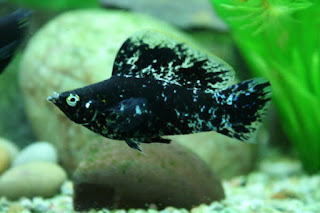Mollies are
among those most popular fish in the aquarium hobby, and the majority of people
have had at one time, at least one of the gentle, a fish eating algae and
appealing live bearers within their fish tank.
 |
Photo copyright from petguide.com
|
Mollies Fish That Eat Algae in Aquarium
Most people erroneously
believe that there's only one species of molly available in fish shops, but
there are in fact three separate species available in the aquarium trade. Yet,
only at that point, a lot of the mollies available are so hybridized, that it
would be impossible to find out which species they originated from.
You will find two
species in the genus Poecilia that are most commonly called mollies (Poecilia
sphenops and Poecilia velifera). There is also plenty of colour variation
within each species. Most mollies are solid black in color.
The mollies in the
above mentioned photograph are marbled mollies that are female. As is seen in
the photo below of a black molly that is male, male mollies have a modified
anal fin called a gonopodium and also an enlarged dorsal fin. The gonopodium is
circled in yellow. Realize that the anal fin appears really different in the
man than in the females.
Housing Molly Algae Eater
The short- finned molly
is undemanding when it comes to supplying an aquarium to them, and most will
happily live in a 10 gallon aquarium. But in case you really need them to
thrive, they must be supplied with a 29 gallon long tank.
If they can be supplied
with a large tank right but like a great many other large fish in the hobby,
the fish will do considerably better over the future. Bigger tanks also possess
the power of offering a more stable environment for the fish, simply because
they'ren’t as prone to the sudden water quality fluctuations that smaller tanks
suffer from.
Tankmates Fish Molly
Additionally, salt
doesn't evaporate and so when you replace water in your tank do not add more
salt. You can, though,, add more salt when making water changes (so long as it
doesn't surpass the recommended salt degree). Some people recommend adding salt
that is less than this for their mollies, but this works for me personally.
Anything you do, don't use iodized salt in your tank or it will kill your fish!
Feed Mollies frequently
Two or three times a
day. A flake food for mollies in particular or algae eaters in general is a
basic food that is appropriate; a few times a week supplement with live food
for example vegetables and daphnia such as finely shredded lettuce or boiled
peas. Supply the fish just as much as they are able to eat within a few
minutes. Remove leftovers.
The molly fish is a
livebearer, meaning its eggs are gestated until highly developed fry are born.
Because it’s doesn’t scatter its eggs, there's usually a higher survival rate
among its fry (as long as the tank doesn’t have any big predators).
Like other live-bearers,
breeding mollies is incredibly easy. It really boils right down to fish
water hordes of babies. But as with
other simple to keep livebearers like guppies, you have to be careful what
ratio of sexes you keep in the aquarium.
Remove of the water as
you do, utilizing a gravel cleaner and pail, siphoning waste. Replace with
fresh dechlorinated water that gets the proper quantity of salt added.
Then the simplest way to
ensure a number of their fry live will be to add some dense plants like Java
moss or some floating plants if mollies have been in a community tank. Their
small size will allow for larger fish to eat them, while the babies are born
highly developed. The more plants that an aquarium has, the better chance that
some fry will reach maturity. Floating plants are the best choice, as fry can
easily hide from adult fish in the dense vegetation near the surface.
Mollies Fish That Eat Algae in Aquarium
4/
5
Oleh
Aquascaper




